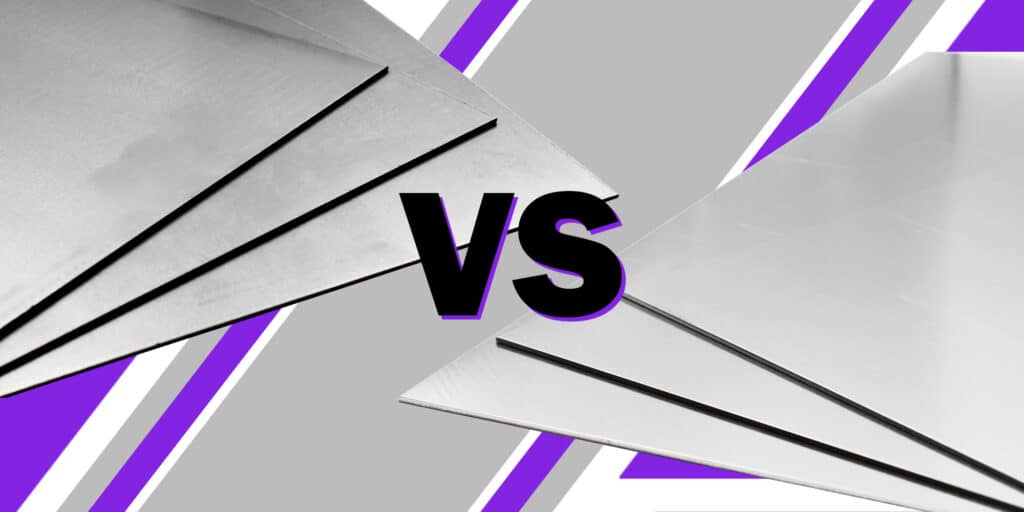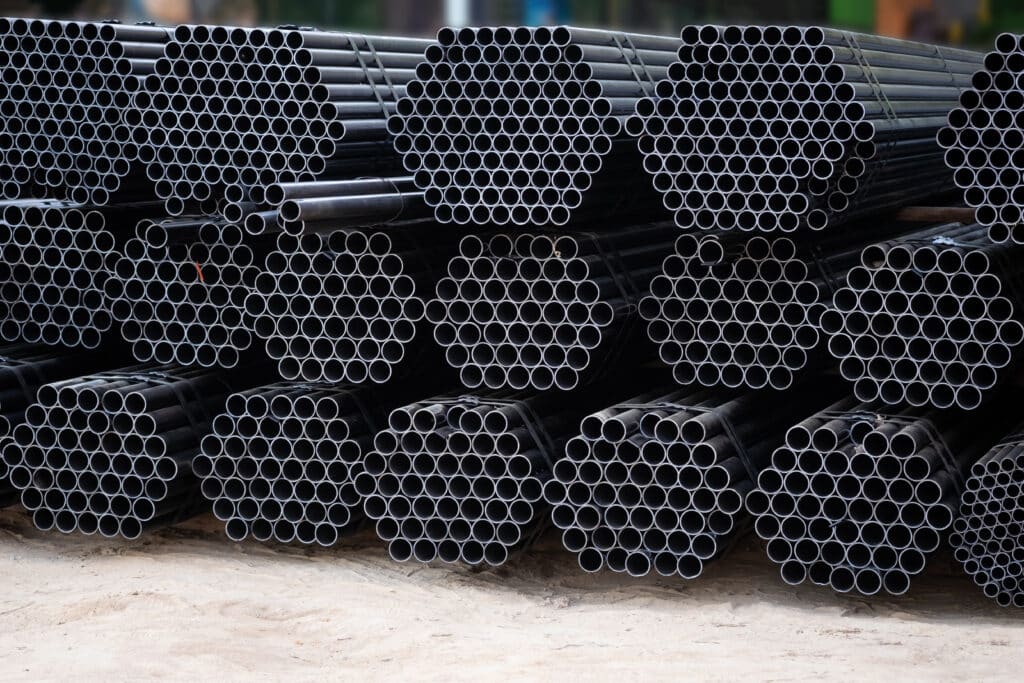- Massive Range
- FREE UK Delivery
- Rapid Dispatch
- Massive Range
- FREE UK Delivery
- Rapid Dispatch
- Massive Range
- FREE UK Delivery
- Rapid Dispatch
Menu
Home » Strength, Weight, and Cost: Breaking Down Mild Steel vs Aluminium

The purpose of this blog post is to explore the comparison of mild steel and aluminium, focusing on three pivotal factors: strength, weight, and cost. Engineers, architects, and designers all rely on these factors when making decisions.
To help you make informed decisions tailored to your specific project requirements, we examine the characteristics, applications, and costs of mild steel and aluminium.
Mild steel, because of its low carbon content, strikes the perfect balance between pliability and strength, making it an essential material in the construction and automotive industries.
Among its key features are excellent weldability, significant tensile strength, and durability, all at a cost-effective price.
Known for its low density, high strength-to-weight ratio, and inherent corrosion resistance, aluminium has earned its fame in the material world. This makes it an ideal candidate for a wide range of applications, from aerospace components to everyday packaging.
Enhanced further through alloying, aluminium’s versatility extends to nearly every field imaginable, offering solutions where weight and resistance play crucial roles.
As a result of its excellent tensile strength, mild steel is capable of withstanding significant stress before failing. Due to its load-bearing capabilities, it is the material of choice for structural applications. As a result of its high strength and resilience to wear and impact, mild steel is the material of choice for constructing buildings, bridges, and infrastructures that are built to last.
Aluminium’s strength-to-weight ratio makes up for its lack of sheer tensile strength. In fields like aerospace and automotive design, reducing weight without compromising structural integrity is crucial. Its durability, especially when alloyed, ensures longevity and resistance against environments that would hasten the degradation of lesser materials.
In terms of strength and durability, mild steel often dominates, especially in applications requiring sheer load-bearing capacity. Aluminium’s lighter weight and comparable strength when alloyed, however, make it a superior choice in industries requiring a balance between durability and weight in order to achieve efficiency and performance.
Density is both a strength and a limitation of mild steel. Mild steel’s heavier nature can be a disadvantage when weight is a critical factor, such as in automotive or mobile structures. As a result of the increased weight, transportation and construction costs will increase, posing challenges in design and implementation.
Aluminium excels in applications that require weight reduction without sacrificing strength. Performance and fuel efficiency can be greatly improved by its use in the automotive and aerospace industries. In addition to being lightweight, the material provides a wider range of design possibilities due to its ease of handling and installation.
Aluminum often outperforms mild steel when weight is a critical factor, providing significant benefits in fuel efficiency, ease of installation, and design flexibility. Mild steel remains the preferred material for projects where weight is less of an issue than cost or structural integrity.


The classic metallic sheen of mild steel complements industrial designs and modern architecture. Its ease of welding, cutting, and shaping allows architects and designers to explore creative avenues without being limited by material limitations. Moreover, mild steel can be coated with a variety of finishes – from paint to powder coating to galvanising – not only to enhance its appearance but also to increase its corrosion and wear resistance. From sleek building frameworks to bespoke furniture, mild steel’s versatility ensures its place in both functional and aesthetic applications.
The silver-white colour and smooth surface of aluminum offer a sleek, contemporary look that is highly valued in modern architecture, automotive design, and consumer electronics. As a result of its ability to reflect light and heat, it contributes not only to its aesthetic qualities but also to its functionality in energy-efficient designs. Anodising aluminium produces a durable, corrosion-resistant finish that can be coloured in a wide range of hues, enhancing its appeal in design-oriented applications. Aside from enhancing the material’s aesthetics, this process also extends its life, which makes aluminium a popular choice for both interior and exterior applications.
A project’s aesthetic appeal will often determine whether mild steel or aluminium should be chosen. Steel provides a traditional, industrial aesthetic that can be tailored through various finishes, whereas aluminium presents a modern, refined appearance that is both elegant and versatile.
Mild steel is highly recyclable, with a significant amount of steel products made from recycled material. Due to its efficiency and low energy consumption, steel recycling reduces its environmental impact. Iron ore, a primary component of steel, can, however, have significant environmental consequences, including habitat destruction and pollution. Despite mild steel’s recyclability, its production and processing stages pose challenges to its sustainability.
Aluminium’s recyclability reduces its environmental footprint significantly. Aluminum recycling saves approximately 95% of the energy required to produce the metal from raw materials. This makes aluminium a highly sustainable material, especially since it can be recycled indefinitely without losing quality. However, bauxite mining, which initially produces aluminium, can cause deforestation and soil erosion due to its energy-intensive production. Despite its substantial environmental benefits in terms of recycling and energy conservation, aluminium’s primary production has considerable environmental impacts.
Both mild steel and aluminium are environmentally friendly due to their recyclability, which reduces resource consumption and energy consumption. Choosing between them should be based on the environmental impact throughout the lifecycle, from production to disposal. For projects where environmental impact is a critical consideration, aluminium, with its lightweight, energy-saving, and recycling advantages, may edge out mild steel. In spite of this, its initial production has a significant environmental impact.
An overall comparison of mild steel and aluminium was conducted to examine their properties, applications, and impact on design and sustainability. In structural projects requiring tensile strength, mild steel is preferred due to its strength, durability, and cost-effectiveness. Lightweight, corrosion-resistant, and environmentally friendly, aluminium is ideal for industries prioritising weight reduction and sustainability.
From mild steel’s industrial appeal to aluminium’s sleek, modern look, both materials are highly recyclable, reducing their environmental impact. Choosing between mild steel and aluminium depends on project-specific requirements, such as strength, weight, cost, aesthetics, and environmental concerns, highlighting the importance of informed material choices.
As always, thank you for checking out our blog. We hope that this helps you with your project.
Please also check out the other articles in our helpful guide series. We have written about ‘Galvanised Steel vs. Aluminium – The Pros and Cons‘ and ‘Stainless Steel Sheet Metal: A Helpful Guide‘ recently so why not check them out?
We are also proud to sell this product on our highly popular eBay store, check us out there too.
If you have any further questions, feel free to contact us.
Speciality Metals
Unit 1, Farrell Street, Warrington,
Cheshire, WA1 2WW, United Kingdom
Quick Links
Payment Options
